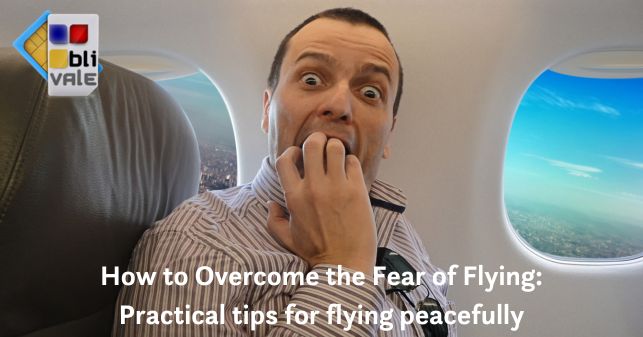Flying on an airplane can be a stressful and anxiety-filled experience for many people. Fear of flying, also known as aerophobia, is a very common condition and can negatively affect the lives of those who suffer from it. Whether it's a short flight or a long trip, the anxiety of getting on a plane can cause physical and mental discomfort, ruining the travel experience.
However, the fear of flying doesn't have to stop us from exploring the world and visiting the places we want. With the right strategies and a little practice, it is possible to learn to manage anxiety and fly in a more peaceful and relaxed way. In this article, we will explore some practical tips and tricks for overcoming your fear of flying and making your next plane trip an enjoyable experience.
Understanding the Fear of Flying
First of all, it is important to understand what the fear of flying comes from and what factors fuel it. This phobia can have several origins, including:
-
Fear of takeoff and landing: Many people fear the moment of takeoff and landing, when the plane experiences the greatest acceleration and turbulence.
-
Fear of losing control: The idea of not having control of the situation and of being completely dependent on the pilot can generate anxiety and panic.
-
Fear of accidents: Some people are afraid that a plane crash might occur, even though flight safety has improved significantly in recent years.
-
Claustrophobia: Being closed in a confined space such as an airplane cabin can trigger feelings of anxiety and claustrophobia.
-
Fear of heights: For some people, the idea of being at high altitude can cause dizziness and fear.
Understanding your fears and their origins is the first step in being able to face and overcome them. This will allow us to adopt the strategies best suited to our specific situation.
Mental and Physical Preparation
Once you have identified your fears, it is important to prepare adequately, both mentally and physically, to face the flight.
Mental Preparation
-
Practice relaxation: Relaxation techniques such as meditation, deep breathing or yoga can help you manage anxiety and stay calm during the flight.
-
View the flight positively: Imagine your plane trip as a pleasant and hassle-free experience. View takeoff, flight and landing in a calm and peaceful manner.
-
Educate yourself about flying: Learn about the processes and procedures of a flight, such as how the aircraft works and the roles of the pilots. This knowledge can help reduce uncertainty and anxiety.
-
Practice distraction: Bring along pleasant activities such as books, music or games that can help you take your mind off your worries during the flight.
-
Ask for support: Share your fears with trusted family or friends. Having their support can be a great help.
Physical training
-
Avoid caffeine and alcohol: These stimulants can make anxiety and agitation worse during the flight.
-
Exercise: Regular physical activity can help reduce stress and improve your overall well-being.
-
Get enough sleep: Make sure you are well rested before your flight, so you can face it with energy and clarity.
-
Eat healthy foods: A balanced, nutrient-rich diet will help you maintain good health and energy.
-
Bring medications or natural remedies: If necessary, consult your doctor about taking medications or natural remedies that can help manage anxiety during the flight.
Taking care of your physical and mental well-being before flying can make a big difference in dealing with your fear of flying.
During the Flight: Strategies for Managing Anxiety
Once on board the plane, here are some strategies to put into practice to manage anxiety and panic:
-
Breathe deeply: Practice slow, deep breathing exercises to calm yourself and reduce physical tension.
-
Distract your mind: Read a book, listen to music, watch a movie, or play a game on your device. Keep your mind busy to avoid focusing on your worries.
-
Communicate with the crew: Don't hesitate to ask the crew for help if you feel particularly anxious or in difficulty. They are trained to handle similar situations and can offer you support and reassurance.
-
Avoid looking outside: Try not to look out the window, especially during takeoff and landing, to avoid being overwhelmed by the sight of heights.
-
Practice muscle relaxation: Do muscle tension and relaxation exercises to reduce the feeling of physical anxiety.
-
Visualize familiar places: Imagine yourself in a safe and dear place, like your home or a place that makes you feel calm.
-
Talk to your travel companions: Share your concerns with the people accompanying you, who can offer you support and reassurance.
-
Remember that it is normal to be afraid: Accept your feelings without judging them. Remember that fear of flying is a common reaction and that you can overcome it.
By implementing these strategies during your flight, you can more effectively manage your anxiety and make the experience less stressful.
Dealing with Airplane Turbulence and Noises
Airplane turbulence and noise are often among the main factors that fuel the fear of flying. Here are some tips for dealing with them:
-
Understanding airplane noises: Learn about the normal sounds the airplane makes during flight, such as engine noise or landing gear noise. This knowledge will help you not interpret them as warning signs.
-
Stay calm during turbulence: Remember that turbulence is normal and does not pose a safety hazard to the aircraft. Practice relaxation techniques and breathe deeply to stay calm.
-
Ask the crew for explanations: Don't hesitate to ask the on-board crew about turbulence or noises that worry you. They will be able to reassure you and provide you with reassuring explanations.
-
Use headphones or earplugs: Wearing headphones or earplugs can help reduce the perception of airplane noise and help you stay calm.
-
Distract your mind: Focus on activities that keep your mind busy, such as reading, listening to music, or watching a movie. This will help you not focus too much on the sounds of the plane.
Dealing calmly with the turbulence and noise of the plane is a fundamental step in overcoming the fear of flying.
Data and Statistics on Fear of Flying
It is not possible to know exactly how many people in the world suffer from fear of flying, also called aviophobia. However, several studies provide us with quite precise estimates:
-
In the world:
-
There are no single and definitive global data, but it is estimated that the percentage of people with aviophobia is between 5% and 10% of the world population.
-
This means there could be 400 million to 800 million people in the world with a fear of flying.
-
It is important to note that the severity of the phobia can vary greatly from person to person.
-
Some individuals may experience simple annoyance or anxiety during the flight, while others may have full-blown panic attacks that force them to avoid flying completely.
The causes of aviophobia can be different, including:
-
Past negative experiences related to flying, such as turbulence or plane crashes.
-
Fear of losing control or finding yourself in a helpless situation.
-
Claustrophobia or fear of confined spaces.
-
Separation anxiety or difficulty staying away from home and loved ones.
If your fear of flying significantly interferes with your daily life, it is important to seek professional help, such as a psychologist or psychotherapist.
List of Phobias on Fear of Flying
Phobias related to the fear of flying can be divided into different categories:
Fear of being on a plane:
-
Aviophobia: General fear of flying and being on an airplane.
-
Claustrophobia: Fear of enclosed, confined spaces, which may intensify on airplanes, especially in window seats or smaller planes.
-
Acrophobia: Fear of heights, which can cause dizziness, nausea and panic during flight.
-
Agoraphobia: Fear of open, crowded spaces, which can manifest itself in anxiety at airports during boarding and disembarking procedures.
Fear of what can happen on a plane:
-
Turbulencephobia: Fear of air turbulence, which can trigger panic attacks.
-
Aerophobia: Fear of plane crashes.
-
Panic attacks: Anxiety disorders with attacks during the flight.
Fear of losing control:
-
Suffocation anxiety: Fear of not being able to breathe on a plane.
-
Fear of losing control: Fear of helplessness during flight.
Other related phobias:
-
Altophobia: Fear of heights.
-
Emetophobia: Fear of vomiting.
-
Iatrosphobia: Fear of doctors.
It is important to underline that not all people who are afraid of flying necessarily suffer from a full-blown phobia. In some cases, the fear may be mild and manageable, while in others it may be more intense and disabling, requiring professional help.
If your fear causes you significant distress and interferes with your daily life, it is important to talk to a doctor or psychologist.
With the right support, you can learn to manage your fear and fly with greater peace of mind.
Conclusion
Fear of flying is a common condition and there are numerous resources available to successfully address it. Through a combination of mental and physical preparation, in-flight strategies for managing anxiety, post-flight reflections on progress made, and awareness of phobias related to fear of flying, it is possible to gradually overcome this emotional challenge.
Remember that you are not alone in your fight against the fear of flying and that there are professionals ready to help you on your path to greater peace of mind when traveling by plane. With determination, patience and adequate support, you will be able to transform the nightmare plane into a means of exploring new horizons with serenity.









